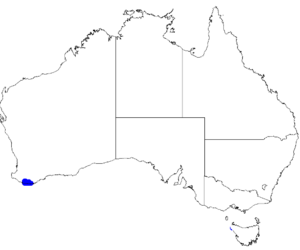Boronia virgata facts for kids
Quick facts for kids Boronia virgata |
|
|---|---|
| Conservation status | |
| Scientific classification | |
 |
|
| Occurrence data from Australasian Virtual Herbarium |
Boronia virgata is a special plant that belongs to the citrus family. You can only find it growing along the south coast of Western Australia. This plant is a type of shrub that has long, slender branches. Its leaves are made up of three to five smaller leaf parts. When it blooms, it has red outer leaves (called sepals) and pretty deep pink, egg-shaped inner leaves (called petals).
Contents
What Does Boronia virgata Look Like?
Boronia virgata is a shrub that usually grows to about 1 meter (about 3 feet) tall. Its small branches have tiny, fine hairs. The leaves are about 10 to 15 millimeters (less than an inch) long. Each leaf has between three and five, and sometimes seven, small leaflets. These leaflets are shaped like an oval or a long rectangle and are 3 to 10 millimeters long.
The flowers grow either by themselves or in groups of three. They appear where the leaves meet the stem (this spot is called a leaf axil). Each flower sits on a thin, smooth stem called a pedicel, which is about 6 to 14 millimeters long.
The red sepals are very narrow and triangular, about 2 to 3 millimeters long, and smooth. The petals are egg-shaped and deep pink. They are about 8 millimeters long and have tiny hairs on their top surface and along the edges of their backs. The stamens, which are the parts that hold pollen, are about 3 millimeters long. The pollen-holding parts, called anthers, are about 1 millimeter long. This plant usually flowers between August and February.
How Was Boronia virgata Named?
The plant Boronia virgata was officially described for the first time in 1971. This was done by a scientist named Paul Wilson. He published his description in a scientific journal called Nuytsia. He had collected samples of the plant near the road between Denmark and Walpole in 1970.
The second part of the plant's name, virgata, comes from a Latin word. Virgatus means "virgate," which describes something that has long, thin, but usually stiff twigs. This perfectly describes the branches of this boronia plant.
Where Does Boronia virgata Grow?
This type of boronia plant likes to grow in open forests. It prefers soil that is wet or even waterlogged during the winter months. You can find it in areas close to the coast, specifically between the towns of Walpole and Nornalup in Western Australia.
Is Boronia virgata Protected?
The Government of Western Australia's Department of Parks and Wildlife has given Boronia virgata a special protection status. It is classified as "Priority Four". This means that the plant is rare or is close to becoming threatened. Protecting these plants helps make sure they continue to grow in the wild for a long time.


